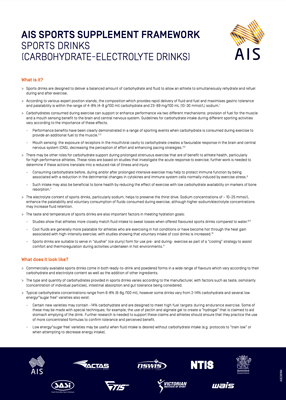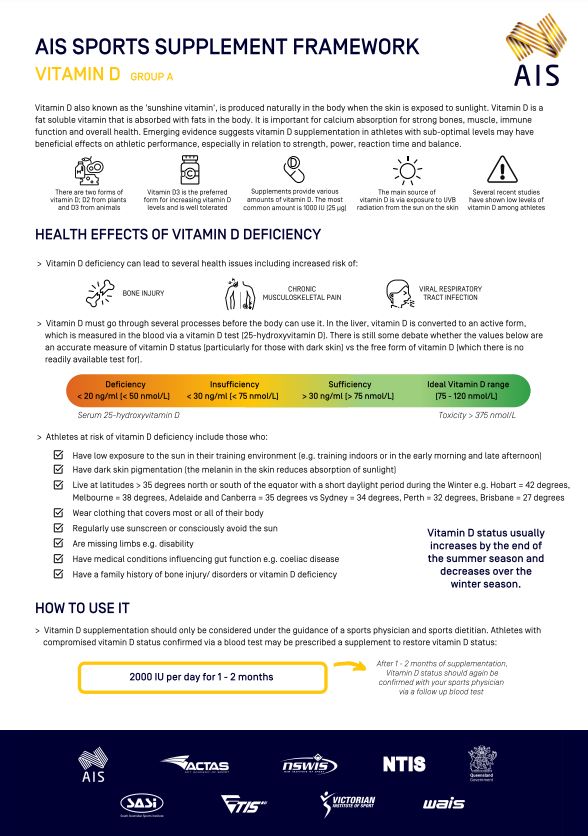Vitamin D
Vitamin D
Vitamin D is classified as a fat soluble vitamin which acts functionally as a hormone and has a structure that is similar to steroid hormones.

Sport-supplement-fact-sheets-Vit-D-v4.pdf

Athlete infographics have been developed for the information of athletes under the direct guidance of a sports dietitian. Sports dietitians have expert knowledge of sports supplements and their potential application in an athletes broader health and performance nutrition strategies. Always engage with a sports dietitian when considering the use of any supplement. https://www.sportsdietitians.com.au/#find-sports-dietitian, opens in a new tab
- Vitamin D is classified as a fat soluble vitamin which acts functionally as a hormone and has a structure that is similar to steroid hormones.
- There are two different isoforms of Vitamin D: D3 (cholecalciferol), which is the important isomer formed in human skin and D2 (ergocalciferol), which is the plant-derived equivalent. D2 was the first isoform to be characterised and was first used in Vitamin D supplements and for food fortification. D3 is now considered preferable. D3 is biologically inert until converted in the liver to 25(OH)D and to 1,25(OH)D in the kidney.1
- Vitamin D plays an important role in calcium and phosphate homeostasis (bone health), gene expression and cell growth. The recent recognition of Vitamin D receptors in most body tissues indicates a role for Vitamin D in many aspects of health and normal function. Vitamin D is now known to be important for optimal muscle function.
- The principal source of circulating Vitamin D comes from exposure to ultraviolet B (UVB) radiation from sunlight.
- In 2010, the Institute of Medicine issued new Dietary Reference Intakes for Vitamin D, assuming no sunlight exposure; this included a Recommended Dietary Intake of 600 IU/d and an upper-Level intake of 4000 IU/d (www.ncbi.nlm.nih.gov/books/NBK56070/pdf/Bookshelf_ NBK56070.pdf, opens in a new tab). The Australian Government Department of Health and the New Zealand Ministry of Health developed a Methodological Framework in 2015 to guide future reviews of priority Nutrient Reference Values (NRVs). Assuming no sunlight exposure, the adequate intake for Vitamin D in Australia is estimated to be 5 – 15 mcg/day (200 – 600 IU/day), depending on age and sex (www.nrv.gov.au/nutrients/vitamin-d, opens in a new tab).
- Vitamin D deficiency can lead to several health issues including increased risk of bone injuries, chronic musculoskeletal pain and viral respiratory tract infections.
- There is also emerging evidence that supplementing Vitamin D in athletes with sub-optimal Vitamin D levels may have beneficial effects on athletic performance, especially in relation to strength, power, reaction time and balance.2-5
- There is no universally accepted definition of Vitamin D deficiency however, the following definitions based on serum levels of 25(OH) Vitamin D are often cited and have the most clinical utility:*Higher status may be preferred for athletes to allow a greater safety margin and to optimize performance; some agencies working with elite athletes often set their own thresholds for desired Vitamin D concentrations.
- Vitamin D deficiency: serum levels < 20 ng/ml (50 nmol/L)
- Vitamin D insufficiency: serum levels < 30 ng/ml (75 nmol/L)
- Vitamin D sufficiency: serum levels > 30 ng/ml (75 nmol/L)
- Ideal Vitamin D range*: 75-120 nmol/L
- Toxicity: > 375 nmol/L when combined with raised serum calcium
- Several recent studies have shown low levels of vitamin D among athletes.6-8
- Vitamin D supplements are available for oral intake and intramuscular therapy. Vitamin D3 is the preferable supplement form and is well tolerated.
- Conversions for Vitamin D3
- Sources: 40 IU = 1 μg
- [serum]: 2.5 nmol/L = 1 ng/mL
- The principal source of Vitamin D comes from exposure to ultraviolet B (UVB) radiation from sunlight (see Table).
Regional recommendations for sun exposure times for individuals with moderately fair skin. Times for people with highly pigmented skin would be3–6 times longer.
Region | Summer 10am or 2pm | Winter10am or 2pm | Winter12 noon |
|---|---|---|---|
Northern Australia (e.g. Cairns) | 6-7 min | 9-12 min | 7 min |
Central Australia (e.g. Brisbane) | 6-7 min | 15-19 min | 11 min |
South Australia | |||
Sydney | 6-8 min | 26-28 min | 16 min |
Melbourne | 7-9 min | 40-47 min | 29 min |
Hobart | 7-9 min | 40-47 min | 29 min |
Adapted from9
- Small amounts of vitamin D can be found in foods such as oily fish, egg yolks and fortified foods such as milk, orange juice, cereals and margarine. However, even Vitamin-D rich food sources generally provide ~ 40–150 IU per serve and will not meet Vitamin D requirements.
- Athletes who are tested and found to have low levels of Vitamin D should be informed about the important role that Vitamin D plays in health and sporting performance and that supplementation is safe and beneficial.
- Depending on time of year, athletes identified with inadequate Vitamin D status will require 2000 IU/day for 1-2 months to restore status. Thereafter, Vitamin D status should again be verified via a blood test.
- Athletes at risk of Vitamin D deficiency include those who:
- Have low exposure to sun in training environment (e.g. training indoors or in early morning and late afternoon).
- Have dark skin pigmentation
- Live at latitudes > 35 degrees north or south of the equator [Brisbane = 27 degrees, Perth = 32 degrees, Sydney = 34 degrees, Adelaide and Canberra = 35 degrees, Melbourne = 38 degrees, Hobart = 42 degrees).
- Wear clothing that covers most or all of their body.
- Regularly use sunscreen or consciously avoid the sun.
- Are missing limbs (e.g. many athletes with disability).
- Have gastrointestinal malabsorption (e.g. Coeliac disease or fat malabsorption syndromes).
- Have a family history of bone injury/disorders or Vitamin D deficiency.
Toxicity
- Over-exposure to UVB (natural sunlight or tanning beds) in an effort to increase vitamin D levels is not recommended as it can lead to sunburn and skin cancer, including melanoma.
- There is some concern, but also dispute, about the level of Vitamin D supplementation that is considered excessive and associated with symptoms of toxicity. More research is required in this area before definitive conclusions can be drawn.
Sports Dietitians Australia www.sportsdietitians.com.au/factsheets/supplements/vitamin-d, opens in a new tab
Gatorade Sports Science Institute www.gssiweb.org/docs/default-source/sse-docs/close_sse_191_v6_final.pdf?sfvrsn=2, opens in a new tab
Supplement safety information www.sportintegrity.gov.au/what-we-do/anti-doping/supplements-sport, opens in a new tab
- Bikle DD. (2014). Vitamin D metabolism, mechanism of action, and clinical applications. Chem Biol, 21(3), 319-329.
- Farrokhyar F, Sivakumar G, Savage K, et al. (2017). Effects of Vitamin D Supplementation on Serum 25-Hydroxyvitamin D Concentrations and Physical Performance in Athletes: A Systematic Review and Meta-analysis of Randomized Controlled Trials. Sports Med, 47(11), 2323-2339.
- Owens D, Allison R, Close G. (2018). Vitamin D and the Athlete: Current Perspectives and New Challenges. Sports Med, 48(Suppl 1), 3-16.
- Sivakumar G, Koziarz A, Farrokhyar F. (2019). Vitamin D Supplementation in Military Personnel: A Systematic Review of Randomized Controlled Trials. Sports Health, 11(5), 425-431.
- Yao P, Bennett D, Mafham M, et al. (2019). Vitamin D and Calcium for the Prevention of Fracture: A Systematic Review and Meta-analysis. JAMA Netw Open, 2(12).
- Aydın C, Dinçel Y, Arıkan Y, et al. (2019). The effects of indoor and outdoor sports participation and seasonal changes on vitamin D levels in athletes. SAGE Open Med, 12, 7.
- Fishman M, Lombardo S, Kharrazi F. (2016). Vitamin D Deficiency Among Professional Basketball Players. Orthopaedic J Sports Med, 4(7).
- Książek A, Zagrodna A, Słowińska-Lisowska M. (2019). Vitamin D, Skeletal Muscle Function and Athletic Performance in Athletes-A Narrative Review. Nutrients, 11(8), 1800.
- Nowson C, McGrath J, Ebeling P,wt al. (2012). Working Group of the Australian and New Zealand Bone and Mineral Society, Endocrine Society of Australia and Osteoporosis Australia. Vitamin D and adult bone health in Australia and New Zealand: A position statement. MJA, 196(11), 686-7.